Assessment of the Sustainability of the Resource-Based Province Shanxi, China Using Emergy Analysis
Abstract
1. Introduction
2. Materials and Methods
2.1. Background of Shanxi Province
2.2. Research Methods
2.3. Emergy Analysis
- (1)
- Collect basic data: After collection, the original data are sorted according to emergy language and classified according to emergy flow, money flow, and waste flow. Energy includes nonrenewable resources and renewable resources;
- (2)
- Draw an energy system diagram: Symbols are used to express emergy flow, whereby various components in the regional system and their interactions can be clarified through an energy flow diagram;
- (3)
- Compile an emergy analysis table: According to the system emergy structure chart and emergy analysis table, the basic emergy data of Shanxi’s eco-economic system can be calculated;
- (4)
- Calculate the emergy index;
- (5)
- Put forward suggestions and conclusions.
2.4. Emergy Indicators
- (1)
- Renewable resource emergy (R) is the quantity of local renewable resource emergy in a year, which can be expressed aswhere the renewable environmental resources (R1) include solar energy, wind energy, rainwater chemical energy, and rainwater potential energy. Renewable organic energy (R2) includes hydropower and wind power. Self-produced renewable resource products (S) include food, vegetables, and fruits.R = R1 + R2 + S,
- (2)
- Nonrenewable resource emergy (N) is the production of local nonrenewable resource emergy in a year, which can be expressed aswhere nonrenewable environmental resources (N1) include topsoil loss energy, and nonrenewable environmental resource products (N2) include raw coal, thermal power, steel, alumina, coke, and cement.N = N1 + N2,
- (3)
- Total emergy (U) is the consumption of local emergy in a year, which can be expressed aswhere U is the total emergy, R is the renewable resource emergy, N is the nonrenewable resource emergy, and I is the local input emergy in a year, including the resources, capital, and commodities imported in Shanxi Province.U = R + N + I,
- (4)
- The population carrying capacity (PCC) is the number of people that can be supported by renewable resources and input resources under current living standards:where R is the renewable resource emergy, U is the total emergy, and P is the number of local people.PCC = 8 × (R/U) × P,
- (5)
- The emergy density (ED) is the ratio of emergy utilization in a country or region to the area of the country or region, in units of sej/(m2·a). The index is used to measure the intensity and level of local economic development. Generally speaking, a greater intensity of emergy indicates a more developed local economy.Here, U is the total emergy, and area refers to the area of the study region.Ed = U/area
- (6)
- The emergy per person (EPP) refers to the per capita emergy consumption in a region, which is an important indicator to measure the per capita living standard. Generally speaking, a higher regional EPP indicates a higher regional per capita living standard.Here, U is the total emergy, and P is the total number of people in the study region.EPP = U/P
- (7)
- The emergy self-sufficiency ratio (ESR) refers to the ratio of the natural environment emergy input to the total emergy in the study area, whereby a higher ESR indicates a higher self-sufficiency level of the system.Here, R is the renewable resource emergy, N is the nonrenewable resource emergy, and U is the total emergy.ESR = (R + N)/U
- (8)
- The emergy yield rate (EYR) refers to the ratio of the total emergy output of the system to the input emergy, which can measure the contribution of system yield emergy value to economic development. A higher EYR indicates a higher system production efficiency, which can reflect the economic competitiveness of the system.Here, U is the total emergy, and I is the local input emergy in a year.EYR = U/I
- (9)
- The emergy exchange rate (EER) refers to the ratio of emergy input to emergy output of a region in the current year, which is used to evaluate the gains and losses of external economic exchanges. A higher emergy exchange rate indicates a greater emergy wealth obtained by the region in economic trade.Here, I is the local input emergy in a year, and O is the local output emergy in a year.EER = I/O
- (10)
- The emergy investment rate (EIR) refers to the ratio between the feedback emergy value and the input emergy value of the natural environment in the eco-environmental economic system of a certain region in the current year. This index is used to measure the degree of economic development and the tolerance of nature to economic activities. A higher EIR value indicates a higher level of economic development.Here, I is the local input emergy in a year, R is the renewable resource emergy, and N is the nonrenewable resource emergy.EIR = I/(R + N)
- (11)
- The emergy monetary ratio (EMR) refers to the total emergy consumption of a region in the current year, except for the gross national product (GNP) or gross domestic product (GDP), in units of sej/USD·a. Generally speaking, a lower EMR indicates a higher degree of regional development and a developed economy.Here, U is the total emergy, and GDP is the gross domestic product of a local area in a year.EMR = U/GDP
- (12)
- The social emergy value of electricity (SEE) refers to the ratio of the amount of emergy used in municipal life to the total amount of emergy used in an area.Here, SE is the consumption of municipal living emergy in a region, and U is the total emergy.SEE = SE/U
- (13)
- The emergy-to-use ratio of electricity (FEE) refers to the ratio of the amount of electricity emergy used in the current year to the total amount of emergy used in a certain area. The ratio of power emergy value can reflect the degree of industrial development in a region and reflect the quality of life and the degree of modernization of local people. A higher emergy value ratio of electricity indicates a more modern life for local residents.Here, E is the consumption of electrical emergy in a region, and U is the total emergy.FEE = E/U
- (14)
- The environmental load ratio (ELR) refers to the ratio of the sum of the nonrenewable resource input and input emergy to the renewable resource emergy of the system in the current year. A higher ELR value indicates more pressure placed by system activities on the environment.Here, N is the nonrenewable resource emergy, I is the local input emergy in a year, and R is the renewable resource emergy.ELR = (N + I)/R
- (15)
- The emergy waste ratio (EWR) refers to the ratio of waste emergy and total emergy of the system in a certain area, which can be used to evaluate the resilience of the system and the recycling rate of resources. A larger EWR indicates a lower waste utilization rate, a lower resource development efficiency, and a greater waste utilization potential in the region.Here, W is the local waste emergy in a year, and U is the total emergy.EWR = W/U
- (16)
- The sustainable development index (ESI) was proposed by emergy experts Brown and Ulgiati in 1998 [41]. Some experts proposed that ESI < 1 indicates a developed country or region, 1 < ESI < 10 indicates a developing country or region, and ESI > 10 indicates an underdeveloped country or region.Here, EYR is the emergy yield rate, and ELR is the environmental load ratio.ESI = EYR/ELR
- (17)
- The evaluation system sustainable development indicator (EISD) refers to the concept proposed by Chinese scholar Hongfang Lu in 2002 [42]. ESID addresses the shortcomings of the ESI index. A higher ESID value indicates better socioeconomic benefits under the same environmental pressure and, thus, a better sustainable development power of the regional eco-economic system.Here, EYR denotes the emergy yield rate, EER is the emergy exchange rate, and ELR is the environmental load ratio.ESID = EYR × EER/ELR
2.5. Data Sources
2.6. Emergy Analysis Tables
3. Results
3.1. Basic Emergy Quantity
3.2. Social Subsystem Evaluation Index
3.3. Economic Subsystem Evaluation Index
3.4. Environmental Subsystem Evaluation Index
3.5. Sustainable Development Evaluation Index
4. Discussion
4.1. Suggestions
- Transform the economic development model and focus on developing a circular economy: In view of the low utilization rate of nonrenewable natural resources in Shanxi Province, we can consider changing the economic development mode from relying solely on resource advantages to combining resource advantages with technical advantages.
- Under the premise of ensuring the Chinese energy supply, find new pillar industries: For example, in the 14th Five-Year Plan (plan for national economic and social development of the People’s Republic of China and the outline of the 2035 Vision Goals), Shanxi set four fields as the key areas for future development: semiconductor materials, carbon-based new materials, biobased new materials, and special metal materials [52].
- Improve the efficiency of economic external communication and strengthen the input of the external emergy value: In view of the low emergy exchange rate of Shanxi Province, we can consider strengthening advanced technology and material introduction. Only by continuously increasing the effort to absorb talents can Shanxi Province move toward scientific and technological innovation. Accordingly, Shanxi Province can transition from resource output to technology output and improve regional market competitiveness.
- Considering China’s goal of achieving a carbon peak by 2030, Shanxi Province should improve the resource utilization structure and vigorously develop new energy. The local government should advocate for the development and utilization of sustainable energy in combination with the large potential of wind, photovoltaic, and bio-energy power generation in Shanxi Province [53] while considering that the output and technology of methanol and hydrogen energy are among the best in the world. Shanxi Province should pay more attention to the efficiency and depth of resource utilization, transitioning from traditional coal mining to coal chemistry and new materials, as well as from traditional metallurgy to equipment manufacturing.
- Cultivate talents related to emerging industries and develop new pillar industries: Shanxi Province, in the 14th Five-Year Plan, listed new energy, high-end equipment manufacturing, general aviation, medical production, photovoltaic industry, and other pillar industries [54]. However, these industries require a large number of talents, so colleges and universities should connect with related industries, set up related majors, undertake related research projects, and promote industrial development with science and technology. The government has taken measures to encourage some high-tech industries by providing tax or financial support.
- Reduce waste discharge and improve the waste disposal rate: We can cooperate with colleges and universities to study the use of science and technology to turn general industrial wastes into new materials. Government departments should organize and guide all sectors of society to raise awareness of environmental protection, strengthen environmental supervision, and strictly investigate illegal factories and mines that do not comply with regulations by releasing waste into the natural world. At the same time, governments should increase financial support for areas with serious environmental pollution and fragile ecology, as well as carry out treatment and restoration.
4.2. Study Contributions and Limitations
5. Conclusions
Author Contributions
Funding
Institutional Review Board Statement
Informed Consent Statement
Data Availability Statement
Conflicts of Interest
Appendix A
| Collection Object | Unit | Original Data | Rate (sej/unit) | Reference | |||||||
|---|---|---|---|---|---|---|---|---|---|---|---|
| 2013 | 2014 | 2015 | 2016 | 2017 | 2018 | 2019 | 2020 | ||||
| Renewable resources R1 | |||||||||||
| 1. Solar energy | J | 6.28 × 1020 | 6.28 × 1020 | 6.28 × 1020 | 6.28 × 1020 | 6.28 × 1020 | 6.28 × 1020 | 6.28 × 1020 | 6.28 × 1020 | 1.00 | [55] |
| 2. Wind energy | J | 6.12 × 1016 | 6.12 × 1016 | 6.12 × 1016 | 6.12 × 1016 | 6.12 × 1016 | 6.12 × 1016 | 6.12 × 1016 | 6.12 × 1016 | 6.23 × 102 | [55] |
| 3. Rainwater chemical energy | J | 4.76 × 1017 | 4.71 × 1017 | 4.24 × 1017 | 5.15 × 1017 | 4.55 × 1017 | 4.26 × 1017 | 3.53 × 1017 | 4.18 × 1017 | 1.82 × 104 | [55] |
| 4. Rainwater potential energy | J | 1.30 × 1018 | 1.21 × 1018 | 1.10 × 1018 | 1.33 × 1018 | 1.24 × 1018 | 1.10 × 1018 | 9.10 × 1017 | 1.23 × 1018 | 1.00 × 104 | [55] |
| 5. Earth cycle energy | J | 1.84 × 1017 | 1.84 × 1017 | 1.84 × 1017 | 1.84 × 1017 | 1.84 × 1017 | 1.84 × 1017 | 1.84 × 1017 | 1.84 × 1017 | 2.90 × 104 | [55] |
| Renewable organic resources R2 | |||||||||||
| 1. Hydroelectric power | J | 1.08 × 1016 | 1.21 × 1016 | 1.31 × 1016 | 1.40 × 1016 | 1.52 × 1016 | 1.54 × 1016 | 1.66 × 1016 | 1.59 × 1016 | 8.00 × 104 | [55] |
| 2. Wind power | J | 2.18 × 1016 | 2.86 × 1016 | 3.85 × 1016 | 4.91 × 1016 | 5.94 × 1016 | 6.78 × 1016 | 7.06 × 1016 | 7.72 × 1016 | 7.00 × 104 | [56] |
| 3. Solar power | J | 8.38 × 1015 | 8.66 × 1015 | 8.98 × 1015 | 9.93 × 1015 | 2.00 × 1016 | 3.37 × 1016 | 4.57 × 1016 | 4.80 × 1016 | 6.25 × 104 | [38] |
| Nonrenewable resource N1 | |||||||||||
| 1. Loss of topsoil | J | 3.73 × 1015 | 3.73 × 1015 | 3.73 × 1015 | 3.73 × 1015 | 3.73 × 1015 | 3.73 × 1015 | 3.73 × 1015 | 3.73 × 1015 | 6.25 × 104 | [55] |
| Non-renewable resource products N2 | |||||||||||
| 1. Natural gas | m3 | 3.56 × 109 | 3.80 × 109 | 4.00 × 109 | 4.30 × 109 | 4.70 × 109 | 5.30 × 109 | 6.50 × 109 | 8.60 × 109 | 1.80 × 1012 | [50] |
| 2. Raw coal | T | 9.20 × 108 | 9.70 × 108 | 9.70 × 108 | 8.30 × 108 | 8.70 × 108 | 9.30 × 108 | 9.90 × 108 | 1.07 × 108 | 8.36 × 1014 | [50] |
| 3. Thermal power | kW·h | 2.30 × 1011 | 2.40 × 1011 | 2.20 × 1011 | 2.01 × 1011 | 2.52 × 1011 | 2.68 × 1011 | 2.98 × 1011 | 2.97 × 1011 | 5.40 × 1011 | [50] |
| 4. Cement | T | 5.30 × 107 | 4.80 × 107 | 3.80 × 107 | 3.90 × 107 | 3.80 × 107 | 4.40 × 107 | 5.00 × 107 | 5.60 × 107 | 2.07 × 1015 | [50] |
| 5. Steel | T | 9.00 × 107 | 9.00 × 107 | 8.10 × 107 | 8.20 × 107 | 8.80 × 107 | 1.03 × 108 | 1.16 × 108 | 1.27 × 108 | 1.40 × 1015 | [50] |
| 6. Aluminum oxide | T | 7.84 × 106 | 7.84 × 106 | 1.27 × 107 | 1.41 × 107 | 1.93 × 107 | 2.02 × 107 | 1.99 × 107 | 1.81 × 107 | 1.63 × 1015 | [38] |
| 7. Aluminum product | T | 1.04 × 106 | 8.26 × 105 | 6.60 × 105 | 8.68 × 105 | 9.85 × 105 | 9.30 × 105 | 7.81 × 105 | 7.61 × 105 | 1.60 × 1016 | [50] |
| 8. Fertilizer | T | 4.47 × 106 | 4.60 × 106 | 4.60 × 106 | 4.40 × 106 | 3.70 × 106 | 3.60 × 106 | 4.00 × 106 | 4.00 × 106 | 2.80 × 1015 | [50] |
| 9. Coke | T | 9.02 × 107 | 8.80 × 107 | 8.00 × 107 | 8.20 × 107 | 8.40 × 107 | 9.30 × 107 | 9.70 × 107 | 1.04 × 108 | 3.50 × 1014 | [38] |
| Self-produced renewable products S | |||||||||||
| 1. Food | T | 1.36 × 107 | 1.38 × 107 | 1.31 × 107 | 1.38 × 107 | 1.36 × 107 | 1.38 × 107 | 1.36 × 107 | 1.40 × 107 | 1.04 × 1015 | [55] |
| 2. Cooking oil | T | 1.81 × 105 | 1.64 × 105 | 1.21 × 105 | 1.59 × 105 | 1.50 × 105 | 1.55 × 105 | 1.37 × 105 | 1.40 × 105 | 2.06 × 1016 | [55] |
| 3. Vegetable | T | 9.32 × 106 | 9.72 × 106 | 8.30 × 106 | 7.86 × 106 | 8.06 × 106 | 8.22 × 106 | 8.28 × 106 | 8.60 × 106 | 1.15 × 1014 | [55] |
| 4. Fruit (fresh) | T | 7.56 × 105 | 7.52 × 105 | 5.20 × 105 | 4.70 × 105 | 4.70 × 105 | 5.30 × 105 | 5.45 × 105 | 5.18 × 105 | 2.30 × 1014 | [55] |
| 5. Meat | T | 8.32 × 105 | 8.73 × 105 | 9.95 × 105 | 8.44 × 105 | 9.30 × 105 | 9.30 × 105 | 9.10 × 105 | 1.02 × 106 | 3.68 × 1016 | [38] |
| 6. Dairy | T | 8.72 × 105 | 9.62 × 105 | 7.77 × 105 | 9.59 × 105 | 7.80 × 105 | 8.16 × 105 | 9.20 × 105 | 1.09 × 106 | 1.42 × 1016 | [38] |
| 7. Poultry and eggs | T | 7.99 × 105 | 8.37 × 105 | 1.08 × 105 | 8.90 × 105 | 1.02 × 106 | 1.02 × 106 | 1.12 × 106 | 1.17 × 106 | 1.42 × 1016 | [38] |
| 8. Vinegar | T | 5.50 × 105 | 4.70 × 105 | 6.70 × 105 | 6.27 × 105 | 5.67 × 105 | 5.18 × 105 | 4.88 × 105 | 4.91 × 105 | 7.15 × 1015 | [57] |
| Waste flow | |||||||||||
| 1. Waste liquid | T | 4.80 × 108 | 4.90 × 108 | 4.10 × 108 | 2.80 × 108 | 2.40 × 108 | 2.20 × 108 | 1.93 × 108 | 1.59 × 108 | 4.30 × 1012 | [58] |
| 2. Waste gas | T | 2.00 × 106 | 1.84 × 106 | 1.50 × 106 | 7.70 × 105 | 5.02 × 105 | 4.70 × 105 | 3.82 × 105 | 4.40 × 105 | 1.32 × 1016 | [58] |
| 3. Waste solid (deduction used) | T | 1.07 × 108 | 1.06 × 108 | 1.42 × 108 | 1.48 × 108 | 2.20 × 108 | 2.37 × 108 | 2.53 × 108 | 2.55 × 108 | 1.24 × 1015 | [58] |
| Regional imported flow | |||||||||||
| 1. Domestic energy input (standard coal) | T | 2.30 × 107 | 7.10 × 107 | 4.60 × 107 | 7.01 × 107 | 6.04 × 107 | 1.20 × 107 | 9.30 × 107 | 6.30 × 107 | 1.17 × 1015 | [50] |
| 2. International goods, funding, and service input | USD | 7.80 × 1012 | 7.30 × 1012 | 6.29 × 1012 | 6.71 × 1012 | 6.97 × 1012 | 8.50 × 1012 | 9.28 × 1012 | 9.13 × 1012 | 7.48 × 1012 | [59] |
| Regional exported flow | |||||||||||
| 1. Domestic energy output (standard coal) | T | 5.50 × 108 | 5.21 × 108 | 5.08 × 108 | 4.50 × 108 | 4.32 × 108 | 5.60 × 108 | 5.50 × 108 | 6.10 × 108 | 1.17 × 1015 | [50] |
| 2. International goods, funding, and service output | USD | 7.99 × 109 | 8.94 × 109 | 8.42 × 109 | 9.93 × 109 | 1.02 × 1010 | 1.23 × 1010 | 1.17 × 1010 | 1.27 × 1010 | 7.48 × 1012 | [59] |
Appendix B
| Collection Object | 2013 | 2014 | 2015 | 2016 | 2017 | 2018 | 2019 | 2020 |
|---|---|---|---|---|---|---|---|---|
| Renewable resources R1 | ||||||||
| 1. Solar energy | 6.28 × 1020 | 6.28 × 1020 | 6.28 × 1020 | 6.28 × 1020 | 6.28 × 1020 | 6.28 × 1020 | 6.28 × 1020 | 6.28 × 1020 |
| 2. Wind energy | 3.81 × 1019 | 3.81 × 1019 | 3.81 × 1019 | 3.81 × 1019 | 3.81 × 1019 | 3.81 × 1019 | 3.81 × 1019 | 3.81 × 1019 |
| 3. Rainwater chemical energy | 8.56 × 1021 | 8.48 × 1021 | 7.64 × 1021 | 9.27 × 1021 | 8.62 × 1021 | 7.68 × 1021 | 6.36 × 1021 | 7.60 × 1021 |
| 4. Rainwater potential energy | 1.30 × 1022 | 1.21 × 1022 | 1.10 × 1022 | 1.33 × 1022 | 1.24 × 1022 | 1.10 × 1022 | 9.10 × 1021 | 1.09 × 1022 |
| 5. Earth cycle energy | 5.34 × 1021 | 5.34 × 1021 | 5.34 × 1021 | 5.34 × 1021 | 5.34 × 1021 | 5.34 × 1021 | 5.34 × 1021 | 5.34 × 1021 |
| Renewable organic resources R2 | ||||||||
| 1. Hydroelectric power | 8.64 × 1020 | 9.86 × 1020 | 1.13 × 1021 | 1.13 × 1021 | 1.23 × 1021 | 1.23 × 1021 | 1.33 × 1021 | 1.27 × 1021 |
| 2. Wind power | 1.53 × 1021 | 2.02 × 1021 | 2.70 × 1021 | 3.43 × 1021 | 4.14 × 1021 | 5.42 × 1021 | 4.94 × 1021 | 5.04 × 1021 |
| 3. Solar power | 5.25 × 1020 | 5.41 × 1020 | 5.61 × 1020 | 6.19 × 1020 | 1.25 × 1021 | 2.31 × 1021 | 2.86 × 1021 | 3.00 × 1021 |
| Nonrenewable resource N1 | ||||||||
| 1. Loss of topsoil | 2.33 × 1020 | 2.33 × 1020 | 2.33 × 1020 | 2.33 × 1020 | 2.33 × 1020 | 2.33 × 1020 | 2.33 × 1020 | 2.33 × 1020 |
| Nonrenewable resource products N2 | ||||||||
| 1. Natural gas | 6.41 × 1021 | 6.84 × 1021 | 7.20 × 1021 | 7.74 × 1021 | 8.46 × 1021 | 9.54 × 1021 | 1.17 × 1022 | 1.55 × 1022 |
| 2. Raw coal | 7.69 × 1023 | 8.11 × 1023 | 8.11 × 1023 | 6.94 × 1023 | 7.27 × 1023 | 7.77 × 1023 | 8.28 × 1023 | 8.95 × 1023 |
| 3. Thermal power | 1.24 × 1023 | 1.30 × 1023 | 1.19 × 1023 | 1.09 × 1023 | 1.36 × 1023 | 1.45 × 1023 | 1.61 × 1023 | 1.60 × 1023 |
| 4. Cement | 1.10 × 1023 | 9.94 × 1022 | 7.87 × 1022 | 8.07 × 1022 | 7.87 × 1022 | 9.11 × 1022 | 1.04 × 1023 | 1.16 × 1023 |
| 5. Steel | 1.26 × 1023 | 1.26 × 1023 | 1.13 × 1023 | 1.15 × 1023 | 1.23 × 1023 | 1.44 × 1023 | 1.62 × 1023 | 1.78 × 1023 |
| 6. Aluminum oxide | 1.28 × 1022 | 1.63 × 1022 | 2.07 × 1022 | 2.30 × 1022 | 3.15 × 1022 | 3.29 × 1022 | 3.24 × 1022 | 2.95 × 1022 |
| 7. Aluminum product | 1.66 × 1022 | 1.32 × 1022 | 1.06 × 1022 | 1.39 × 1022 | 1.58 × 1022 | 1.49 × 1022 | 1.25 × 1022 | 1.22 × 1022 |
| 8. Fertilizer | 1.25 × 1022 | 1.29 × 1022 | 1.29 × 1022 | 1.23 × 1022 | 1.04 × 1022 | 1.01 × 1022 | 1.12 × 1022 | 1.12 × 1022 |
| 9. Coke | 3.16 × 1022 | 3.08 × 1022 | 2.80 × 1022 | 2.87 × 1022 | 2.94 × 1022 | 3.26 × 1022 | 3.40 × 1022 | 3.64 × 1022 |
| Self-produced renewable products S | ||||||||
| 1. Food | 1.41 × 1022 | 1.44 × 1022 | 1.36 × 1022 | 1.44 × 1022 | 1.41 × 1022 | 1.44 × 1022 | 1.41 × 1022 | 1.46 × 1022 |
| 2. Cooking oil | 3.73 × 1021 | 3.38 × 1021 | 2.49 × 1021 | 3.28 × 1021 | 3.09 × 1021 | 3.19 × 1021 | 2.82 × 1021 | 2.88 × 1021 |
| 3. Vegetable | 1.07 × 1021 | 1.12 × 1021 | 9.55 × 1020 | 9.04 × 1020 | 9.27 × 1020 | 9.45 × 1020 | 9.52 × 1020 | 9.89 × 1020 |
| 4. Fruit (fresh) | 1.74 × 1020 | 1.73 × 1020 | 1.20 × 1020 | 1.08 × 1020 | 1.08 × 1020 | 1.22 × 1020 | 1.25 × 1020 | 1.19 × 1020 |
| 5. Meat | 3.06 × 1022 | 3.21 × 1022 | 3.66 × 1022 | 3.11 × 1022 | 3.42 × 1022 | 3.42 × 1022 | 3.35 × 1022 | 3.75 × 1022 |
| 6. Dairy | 1.24 × 1022 | 1.37 × 1022 | 1.10 × 1022 | 1.36 × 1022 | 1.11 × 1022 | 1.16 × 1022 | 1.31 × 1022 | 1.55 × 1022 |
| 7. Poultry and eggs | 1.13 × 1022 | 1.19 × 1022 | 1.53 × 1022 | 1.26 × 1022 | 1.45 × 1022 | 1.45 × 1022 | 1.59 × 1022 | 1.66 × 1022 |
| 8. Vinegar | 3.93 × 1021 | 3.36 × 1021 | 4.79 × 1021 | 4.48 × 1021 | 4.05 × 1021 | 3.70 × 1021 | 3.49 × 1021 | 3.51 × 1021 |
| Waste flow | ||||||||
| 1. Waste liquid | 2.06 × 1021 | 2.11 × 1021 | 1.76 × 1021 | 1.20 × 1021 | 1.03 × 1021 | 9.46 × 1020 | 8.30 × 1020 | 6.84 × 1020 |
| 2. Waste gas | 2.64 × 1022 | 2.43 × 1022 | 1.98 × 1022 | 1.02 × 1022 | 6.63 × 1021 | 6.20 × 1021 | 5.04 × 1021 | 5.81 × 1021 |
| 3. Waste solid (deduction used) | 1.33 × 1023 | 1.31 × 1023 | 1.76 × 1023 | 1.84 × 1023 | 2.73 × 1023 | 2.94 × 1023 | 3.14 × 1023 | 3.16 × 1023 |
| Regional imported flow | ||||||||
| 1. Domestic energy input (standard coal) | 2.70 × 1022 | 8.31 × 1022 | 5.38 × 1022 | 8.20 × 1022 | 7.07 × 1022 | 1.40 × 1023 | 1.09 × 1023 | 7.37 × 1022 |
| 2. International goods, funding, and service input | 5.83 × 1022 | 5.46 × 1022 | 4.70 × 1022 | 5.02 × 1022 | 5.21 × 1022 | 6.36 × 1022 | 6.94 × 1022 | 6.83 × 1022 |
| Regional exported flow | ||||||||
| 1. Domestic energy output (standard coal) | 6.43 × 1023 | 6.10 × 1023 | 5.94 × 1023 | 5.27 × 1023 | 5.05 × 1023 | 6.55 × 1023 | 6.44 × 1023 | 7.14 × 1023 |
| 2. International goods, funding, and service output | 5.98 × 1022 | 6.69 × 1022 | 6.30 × 1022 | 7.43 × 1022 | 7.63 × 1022 | 9.20 × 1022 | 8.75 × 1022 | 9.50 × 1022 |
References
- BP Statistical Yearbook of World Energy. Available online: https://www.ourenergypolicy.org/resources/ (accessed on 1 November 2022).
- China Mineral Resources Report 2022. Available online: https://www.mnr.gov.cn/sj/sjfw/kc_19263/zgkczybg/202209/t20220921_2759600.html (accessed on 1 November 2022).
- Scherer, L.; Behrens, P.; de Koning, A.; Heijungs, R.; Sprecher, B.; Tukker, A. Trade-offs between social and the environmental sustainable development goals. Environ. Sci. Policy 2018, 90, 65–72. [Google Scholar] [CrossRef]
- Nan, D. Seize the opportunity and meet the challenge to push China’s sustainable development strategy to a new stage. Chin. J. Popul. Resour. Environ. 2004, 3, 3–6. [Google Scholar] [CrossRef]
- Shanxi Province 2021 National Economic and Social Development Statistical Bulletin. Available online: http://tjj.shanxi.gov.cn/tjsj/tjgb/202203/t20220318_5450337.shtml (accessed on 1 July 2022).
- Wang, Y.; Guo, D.; Zhang, H.; Shen, B. Spatial distribution and applications of coal resource potential in China. J. Nat. Resour. 2006, 21, 225–230. [Google Scholar]
- Shanxi Statistical Yearbook (2013–2020). Available online: http://tjj.shanxi.gov.cn/tjsj/ (accessed on 25 March 2022).
- China Statistical Yearbook. Available online: http://www.stats.gov.cn/tjsj/ndsj/ (accessed on 25 March 2022).
- The State Council on the Issuance of National Resource-Based Cities Notice of the Sustainable Development Plan (2013–2020). Available online: http://www.gov.cn/jrzg/2013-12/03/content_2540561.htm (accessed on 18 August 2022).
- Liang, S.; Zhang, T. Urban metabolism in China achieving dematerialization and decarbonization in Suzhou. J. Ind. Ecol. 2011, 15, 420–434. [Google Scholar] [CrossRef]
- Ascione, M.; Campanella, L.; Cherubini, F.; Ulgiati. Environmental driving forces of urban growth and development: An emergy-based assessment of the city of Rome, Italy. Landsc. Urban Plan. 2009, 93, 238–249. [Google Scholar] [CrossRef]
- Yanitsky, O.N. Sustainability and risk: The case of Russia. Innov. Eur. J. Soc. Sci. Res. 2000, 13, 265–277. [Google Scholar] [CrossRef]
- Hassanzadehkermanshahi, K.; Shirowzhan, S. Measuring urban sustainability over time at national and regional scale for addressing united nations sustainable development goal (SDG) 11: Iran and Tehran as case studies. Sustainability 2022, 14, 7402. [Google Scholar] [CrossRef]
- Mohamadzadeh, P.; Pourmoradian, S.; Feizizadeh, B.; Sharifi, A.; Vogdrup-Schmidt, M. A gis-based approach for spatially-explicit sustainable development assessments in east Azerbaijan province, Iran. Sustainability 2020, 12, 10413. [Google Scholar] [CrossRef]
- Ding, L.; Shao, Z.; Zhang, H.; Xu, C.; Wu, D. A comprehensive evaluation of urban sustainable development in China based on the TOPSIS-entropy method. Sustainability 2016, 8, 746. [Google Scholar] [CrossRef]
- Jing, Z.; Wang, J. Sustainable development evaluation of the society–economy–environment in a resource-based city of China: A complex network approach. J. Clean. Prod. 2020, 263, 121510. [Google Scholar] [CrossRef]
- Li, L.; Lei, Y.; Pan, D.; Si, C. Research on sustainable development of resource-based cities based on the DEA approach: A case study of Jiaozuo, China. Math. Probl. Eng. 2016, 2016, 5024837. [Google Scholar] [CrossRef]
- Pan, Y.; Zhang, B.; Wu, Y.; Tian, Y. Sustainability assessment of urban ecological-economic systems based on emergy analysis: A case study in Simao, China. Ecol. Indic. 2021, 121, 107157. [Google Scholar] [CrossRef]
- Wei, Y.; Li, Y.; Liu, X.; Wu, M. Sustainable development and green gross domestic product assessments in megacities based on the emergy analysis method—A case study of Wuhan. Sustain. Dev. 2020, 28, 294–307. [Google Scholar] [CrossRef]
- Amiri, Z.; Asgharipour, M.R.; Campbell, D.E.; Armin, M. A sustainability analysis of two rapeseed farming ecosystems in Khorramabad, Iran, based on emergy and economic analyses. J. Clean. Prod. 2019, 226, 1051–1066. [Google Scholar] [CrossRef] [PubMed]
- Zhang, X.; Deng, S.; Wu, J.; Jiang, W. A sustainability analysis of a municipal sewage treatment ecosystem based on emergy. Ecol. Eng. 2010, 36, 685–696. [Google Scholar] [CrossRef]
- Brown, M.; Ulgiati. Energy-based indices and ratios to evaluate sustainability: Monitoring economies and technologytoward environmentally sound innovation. Ecol. Eng. 1997, 9, 51–70. [Google Scholar] [CrossRef]
- Hongfang, L.; Zheng, Y.; Xinfeng, Z.; Shaolin, P. A new emergy index for urban sustainable development. Acta Ecol. Sin. 2003, 23, 1363–1368. [Google Scholar]
- Liu, B.; Wang, J.; Jing, Z.; Tang, Q. Measurement of sustainable transformation capability of resource-based cities based on fuzzy membership function: A case study of Shanxi province, China. Resour. Policy 2020, 68, 101739. [Google Scholar] [CrossRef]
- Cao, X. Challenges and potential improvements in the policy and regulatory framework for sustainable tourism planning in China: The case of Shanxi province. J. Sustain. Tour. 2015, 23, 455–476. [Google Scholar] [CrossRef]
- Cui, H.; Wu, R.; Zhao, T. Sustainable development study on an energy-economic-environment system based on a vector autoregression model in Shanxi, China. Pol. J. Environ. Stud. 2019, 28, 1623. [Google Scholar] [CrossRef]
- Hong, G.; Kai, Z.; Hanwen, Z. Research on sustainable development of resource-based small industrial and mining cities—A case study of Yangquanqu town, Xiaoyi, Shanxi province, China. Procedia Eng. 2011, 21, 633–640. [Google Scholar] [CrossRef]
- Wang, R.-P.; Rong, X.-M. Emergy analysis of agro-ecolomic system in Shanxi province. Yingyong Shengtai Xuebao 2008, 19, 2259–2264. [Google Scholar]
- Guo, X.; Dong, S.; Wang, G.; Lu, C. Emergy-based urban ecosystem health evaluation for a typical resource-basedcity: A case study of Taiyuan, China. Appl. Ecol. Environ. Res. 2019, 17, 15131–15149. [Google Scholar] [CrossRef]
- Liu, X.; Guo, P.; Nie, L. Applying emergy and decoupling analysis to assess the sustainability of Chinas coal miningarea. J. Clean. Prod. 2020, 243, 118577. [Google Scholar] [CrossRef]
- Into the Shanxi Province. Available online: http://www.shanxi.gov.cn/zjsx/ (accessed on 19 August 2022).
- The Natural Environment. Available online: http://www.Shanxi.gov.cn/zjsx/zlssx/zrdl/202007/t20200724_6045042.shtml (accessed on 20 August 2022).
- The General Picture of Province. Available online: http://www.Shanxi.gov.cn/zjsx/zlssx/sqgk/202007/t20200724_6045048.shtml (accessed on 20 August 2022).
- Shanxi Provincial Water Resources Bulletin. Available online: http://slt.Shanxi.gov.cn/zncs/szyc/szygb/ (accessed on 19 August 2022).
- The GDP of Shanxi Province Increased by 9.1% and Crossed the 2 Trillion Yuan Mark. Available online: http://sx.people.com.cn/n2/2022/0120/c189132-35103957.html (accessed on 20 August 2022).
- Odum, H.T. Energy Environment and Economy—Guidance for Systems Analysis; Oriental Publishing House: Beijing, China, 1992; pp. 154–196. [Google Scholar]
- Odum, H.T. Self-organization, transformity, and information. Science 1988, 242, 1132–1139. [Google Scholar] [CrossRef] [PubMed]
- Lan, S.; Qin, P.; Lu, H. Emergy Analysis of Eco-Economic System; Environmental Science and Engineering Press of Chemical Industry Press: Beijing, China, 2002; pp. 75–76. [Google Scholar]
- Sui, C.; Lu, H.; Zheng, F. Integrative study of Guangdong ecological-economic system based on emergy analysis. YingYong Sheng Tai Xue Bao = J. Appl. Ecol. 2006, 17, 2147–2152. [Google Scholar]
- Li, S.; Li, X.; Zheng, D. Emergy analysis of evaluating sustainable Chinese economy. J. Nat. Resour. 2001, 4, 297–304. [Google Scholar]
- Ulgiati, S.; Brown, M.T. Monitoring patterns of sustainability in natural and man-made ecosystems. Ecol. Model. 1998, 108, 23–36. [Google Scholar] [CrossRef]
- Lu, H.; Lan, S.; Peng, S. Extending study on energy indices for sustainable development. Environ. Sci. 2003, 24, 150–154. [Google Scholar]
- Surface Meteorological Data/Upper Air Meteorological Data. Available online: http://www.nmic.cn/ (accessed on 21 August 2022).
- Shanxi Provincial Government Work Report (2013–2020). Available online: http://www.shanxi.gov.cn/szf/zfgzbg/szfgzbg/ (accessed on 28 August 2022).
- The Report of Shanxi Provincial Department of Ecology and Environmental Protection (2013–2020). Available online: http://sthjt.shanxi.gov.cn/zfxxgk/xxgknb/ (accessed on 5 September 2022).
- Ulgiati, S.; Odum, H.T.; Bastianoni, S. Emergy use, environmental loading and sustainability an emergy analysis of Italy. Ecol. Model. 1994, 73, 215–268. [Google Scholar] [CrossRef]
- Office Shanxi Provincial Agenda 21 Leading Group. Shanxi 21st Century Agenda; Shanxi People’s Publishing House: Taiyuan, China, 1999. [Google Scholar]
- Shanxi Industry Sets Foot on a New Journey of High Quality Development: Shanxi Economy in the 70 Years Since the Founding of New China-Third Report in the Series on Achievements in Social Development. Available online: http://tjj.yq.gov.cn/jjck/201911/t20191111_941690.html (accessed on 1 September 2022).
- Do Our Best to Ensure Energy Supply! Shanxi Has Supplied 21.87 Million Tons of Thermal Coal to 14 Provinces Autonomous Regions and Municipalities. Available online: http://www.shanxi.gov.cn/yw/sxyw/202111/t20211123_945401.shtml (accessed on 11 September 2022).
- Odum, H.T.; Brown, M.; Brandt-Williams, S. Handbook of Emergy Evaluation; Center for Environmental Policy: Gainesville, FL, USA, 2000. [Google Scholar]
- Qi, W.; Deng, X.; Chu, X.; Zhao, C.; Zhang, F. Emergy analysis on urban metabolism by counties in Beijing. Phys. Chem. Earth Parts A/B/C 2017, 101, 157–165. [Google Scholar] [CrossRef]
- Shanxi’s New Plan: Equipment Manufacturing Industry Revenue to Reach 450 Billion Yuan in 2025. Available online: http://www.gov.cn/xinwen/2021-06/18/content_5618946.htm (accessed on 3 September 2022).
- Zhou, J. Shanxi new energy industry development status analysis. Brand 2015, 9, 27–28. [Google Scholar]
- Shanxi "14th Five-Year” 14 Strategic Emerging Industries Issued Regulations. Available online: http://www.mof.gov.cn/zhengwuxinxi/xinwenlianbo/shanxicaizhengxinxilianbo/202106/t20210624_3724430.htm (accessed on 22 September 2022).
- Odum, H.T. Environmental accounting: Emergy and environmental decision making. Choice Rev. Online 1996, 34. [Google Scholar] [CrossRef]
- Yang, Q.; Chen, G.; Liao, S.; Zhao, Y.; Peng, H.; Chen, H. Environmental sustainability of wind power: An emergy analysis of a Chinese wind farm. Renew. Sustain. Energy Rev. 2013, 25, 229–239. [Google Scholar] [CrossRef]
- Li, J.; Chen, F.; Wang, Z. Urban environmental economic emergy synthesis and sustainability analysis. Acta Ecol. Sin. 2006, 2, 439–448. [Google Scholar]
- Wang, C.; Zhang, Y.; Liu, C.; Hu, F.; Zhou, S.; Zhu, J. Emergy-based assessment and suggestions for sustainable development of regional ecological economy: A case study of Anhui province, China. Sustainability 2021, 13, 2988. [Google Scholar] [CrossRef]
- Brown, M.T.; Ulgiati, S. Emergy evaluations and environmental loading of electricity production systems. J. Clean. Prod. 2002, 10, 321–334. [Google Scholar] [CrossRef]
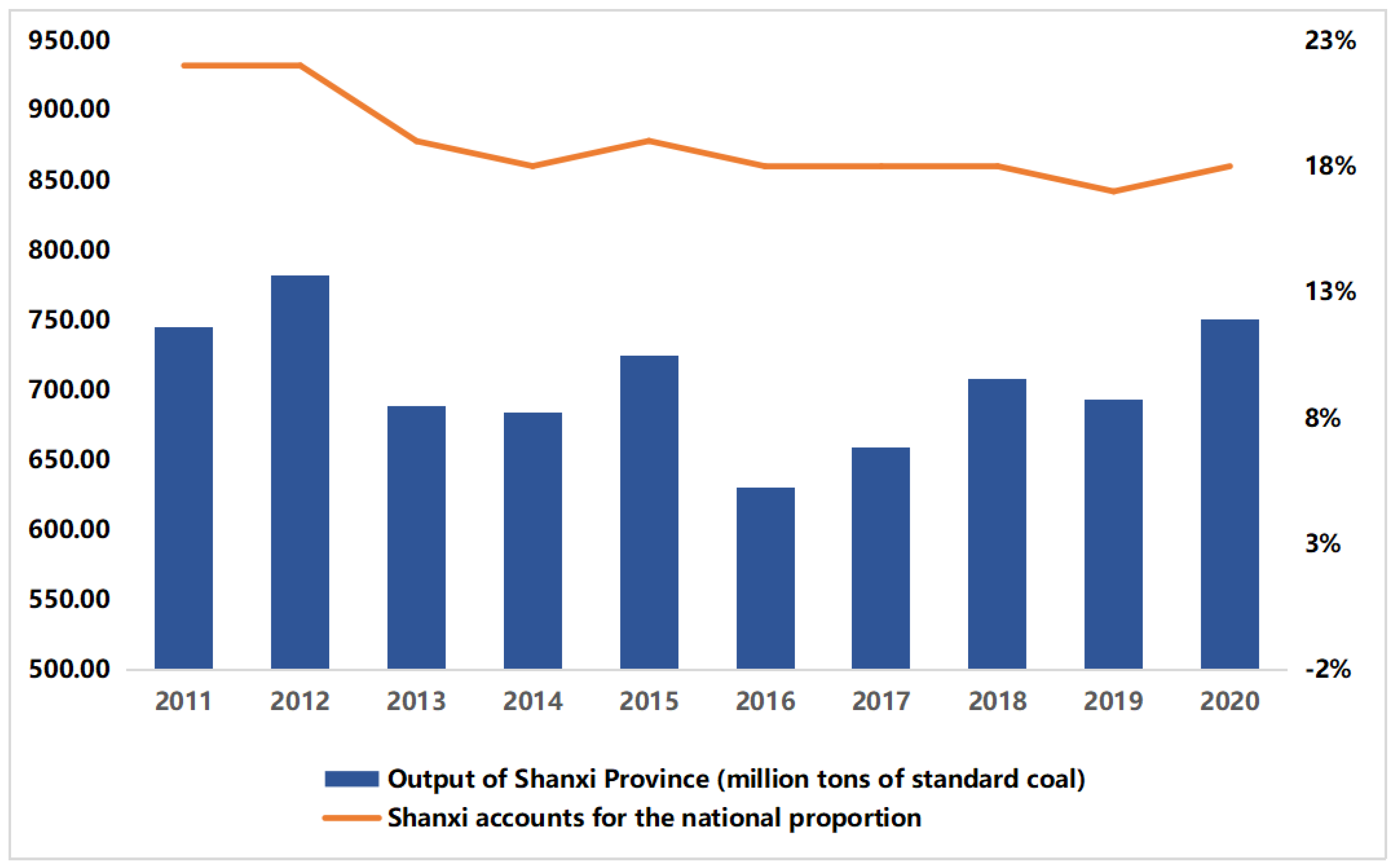
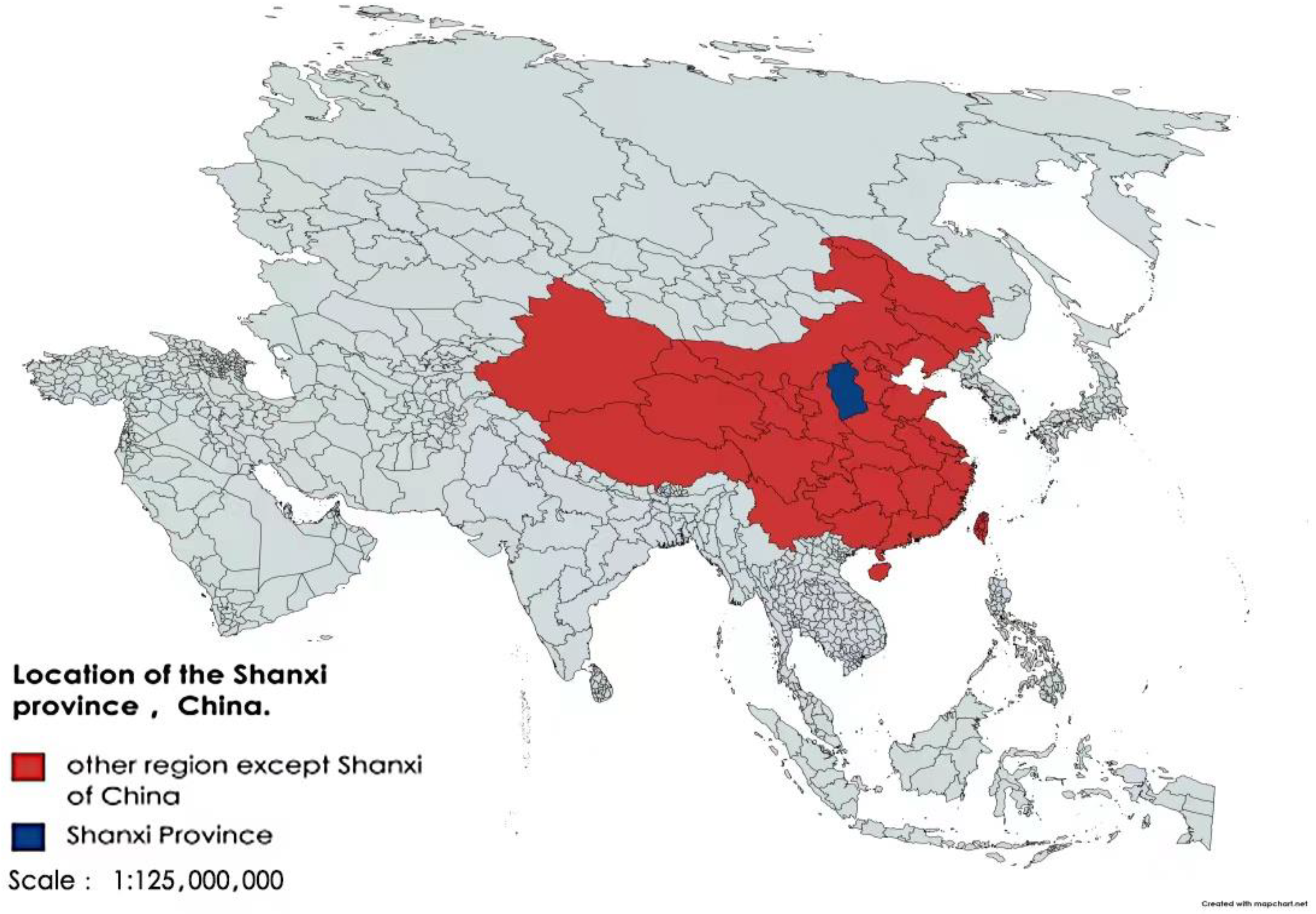
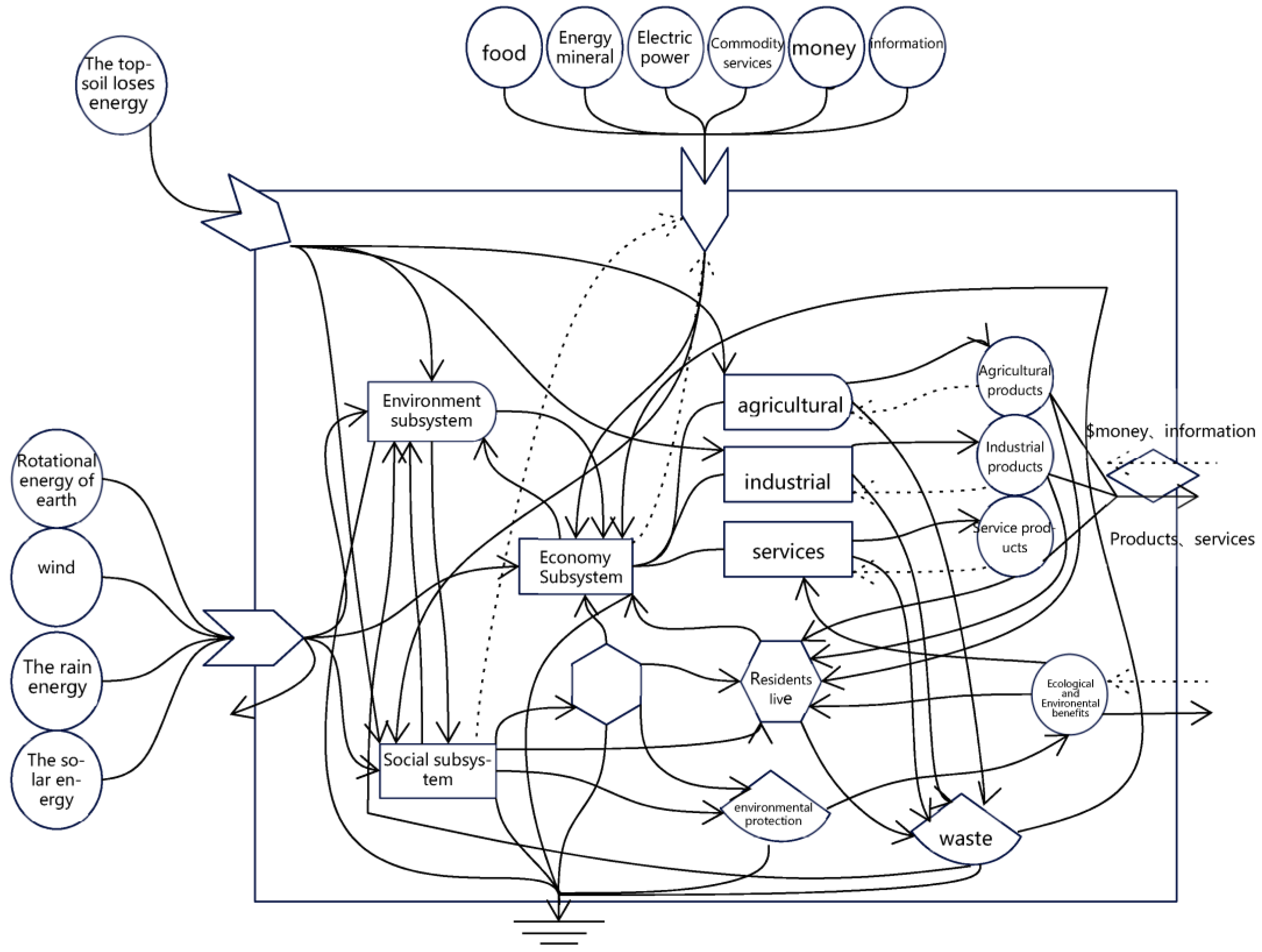
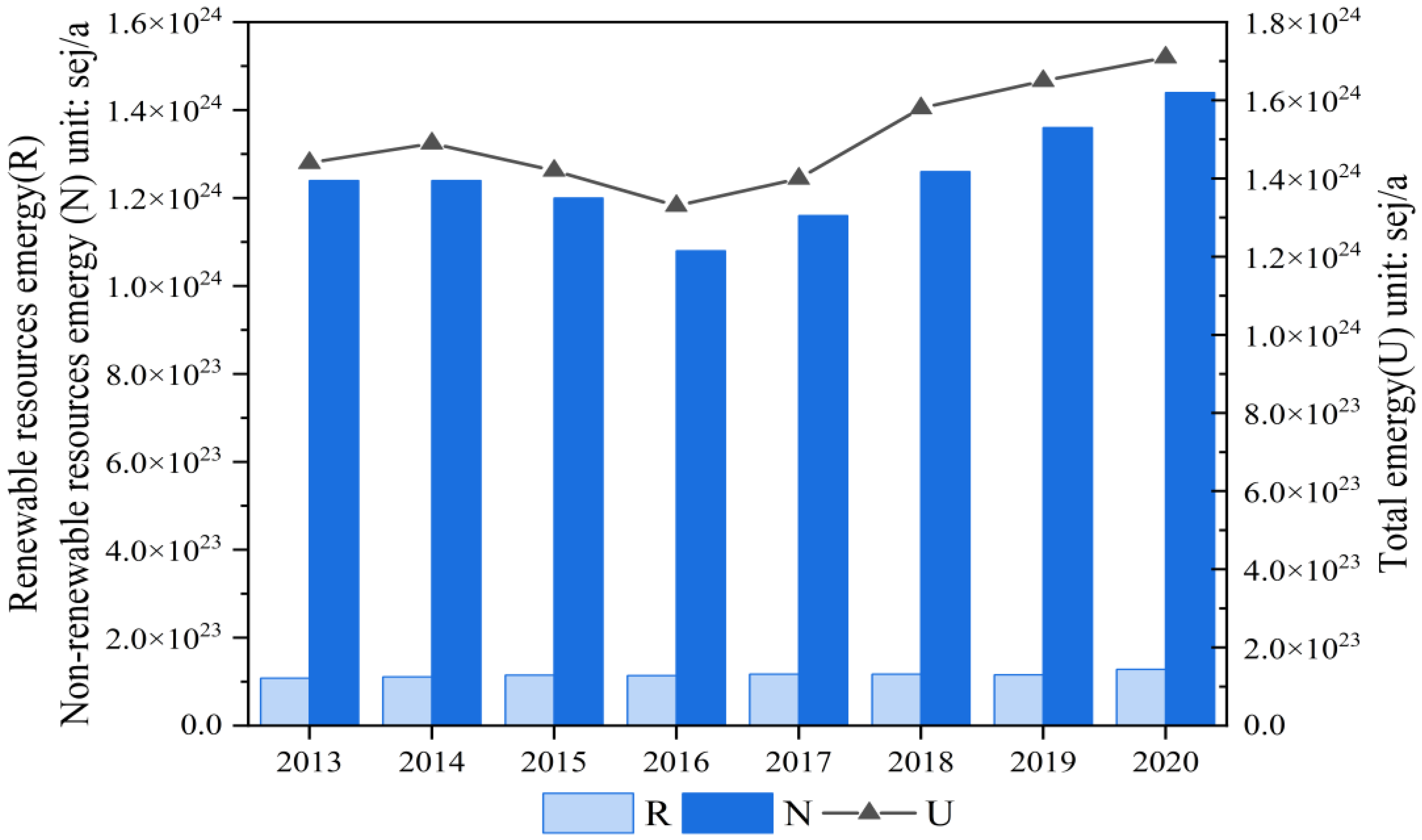
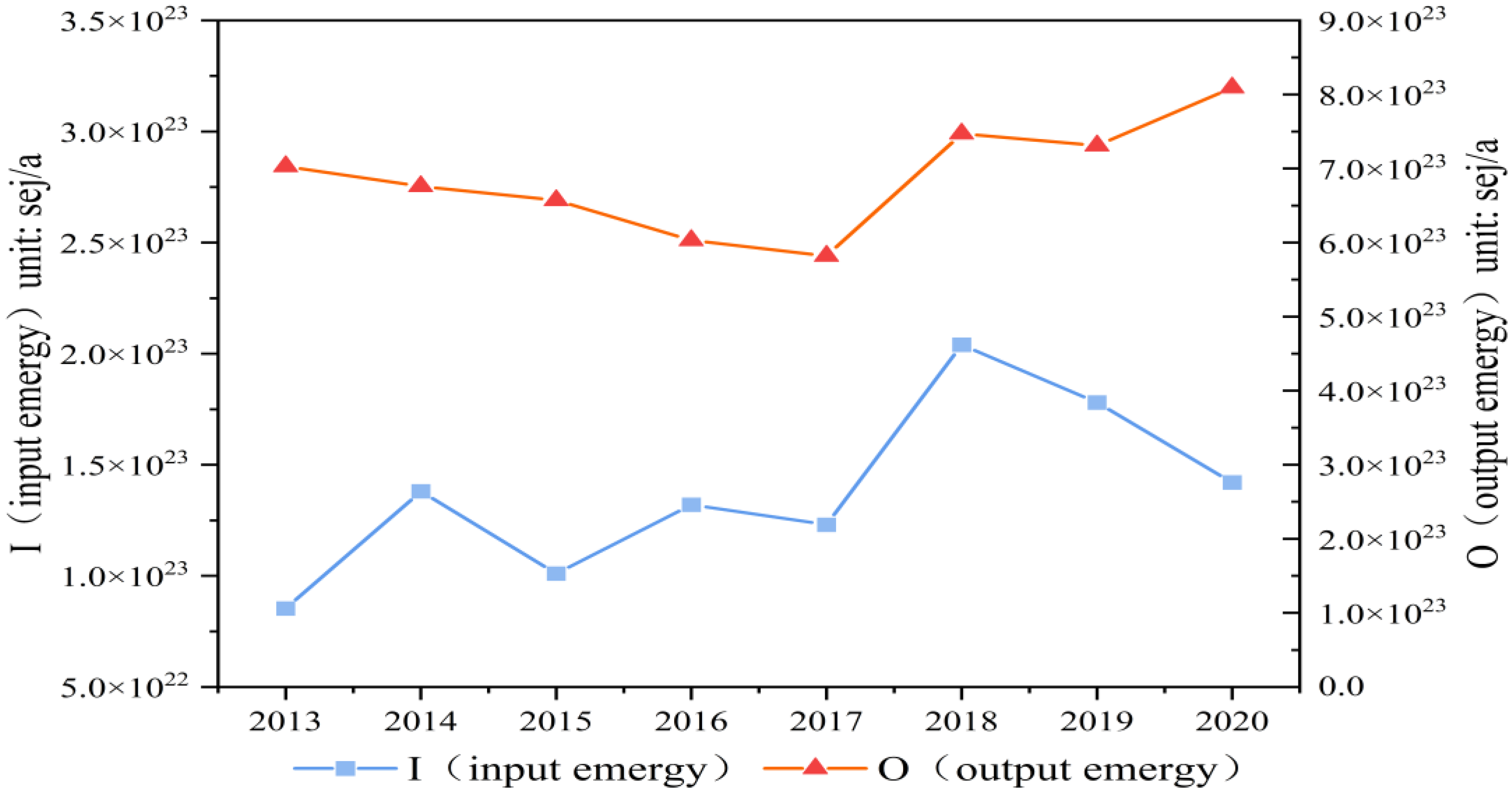
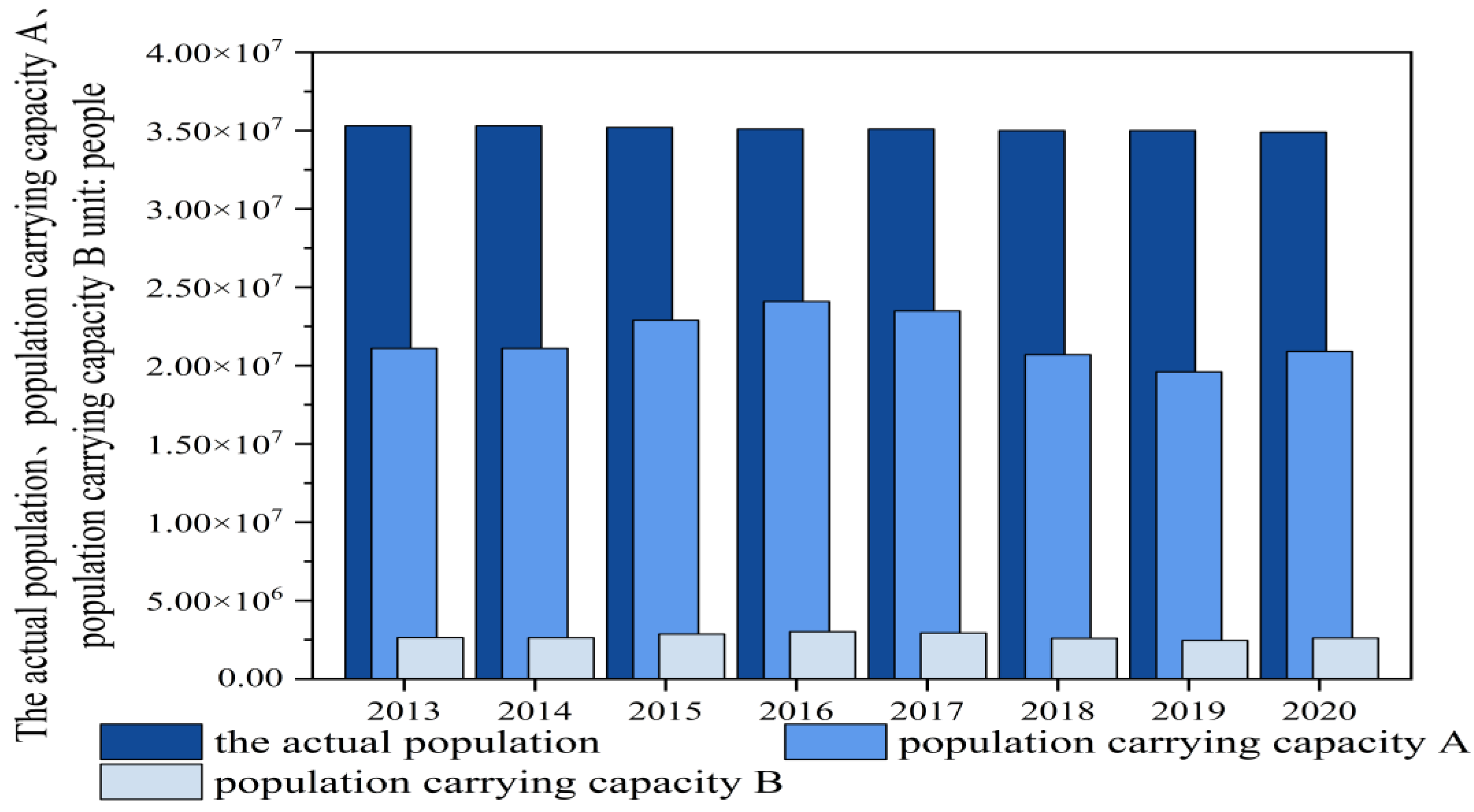
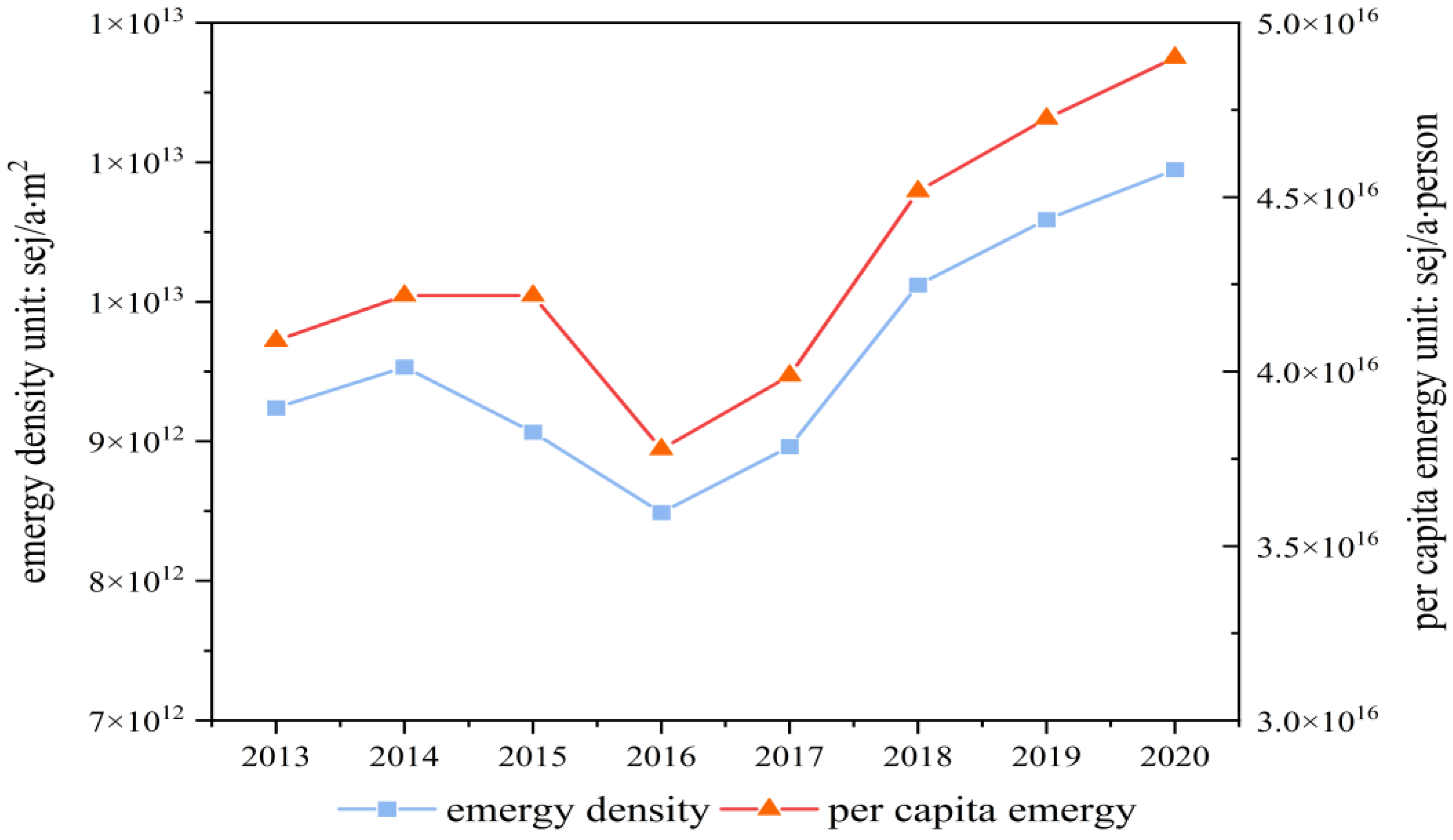
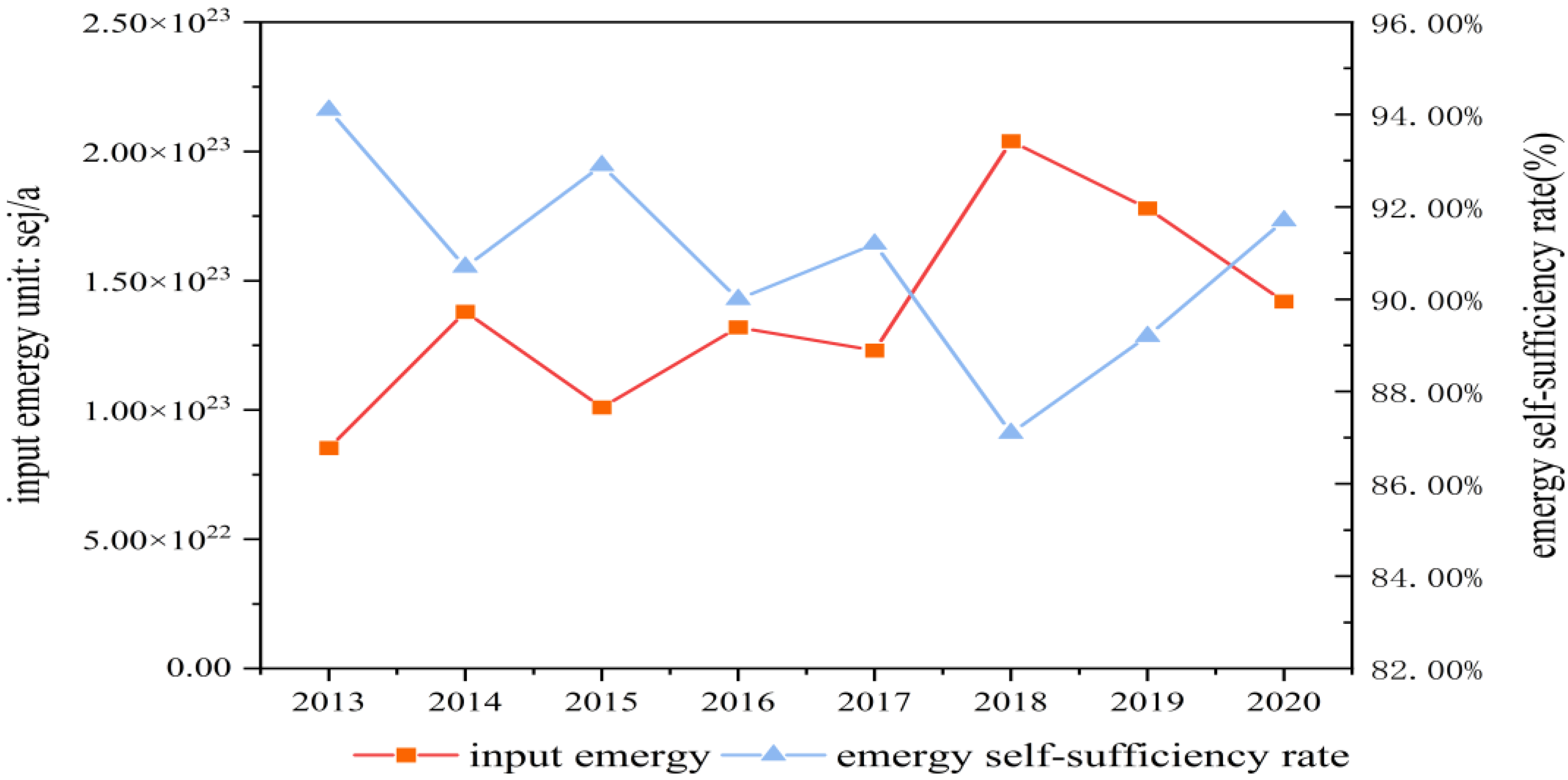
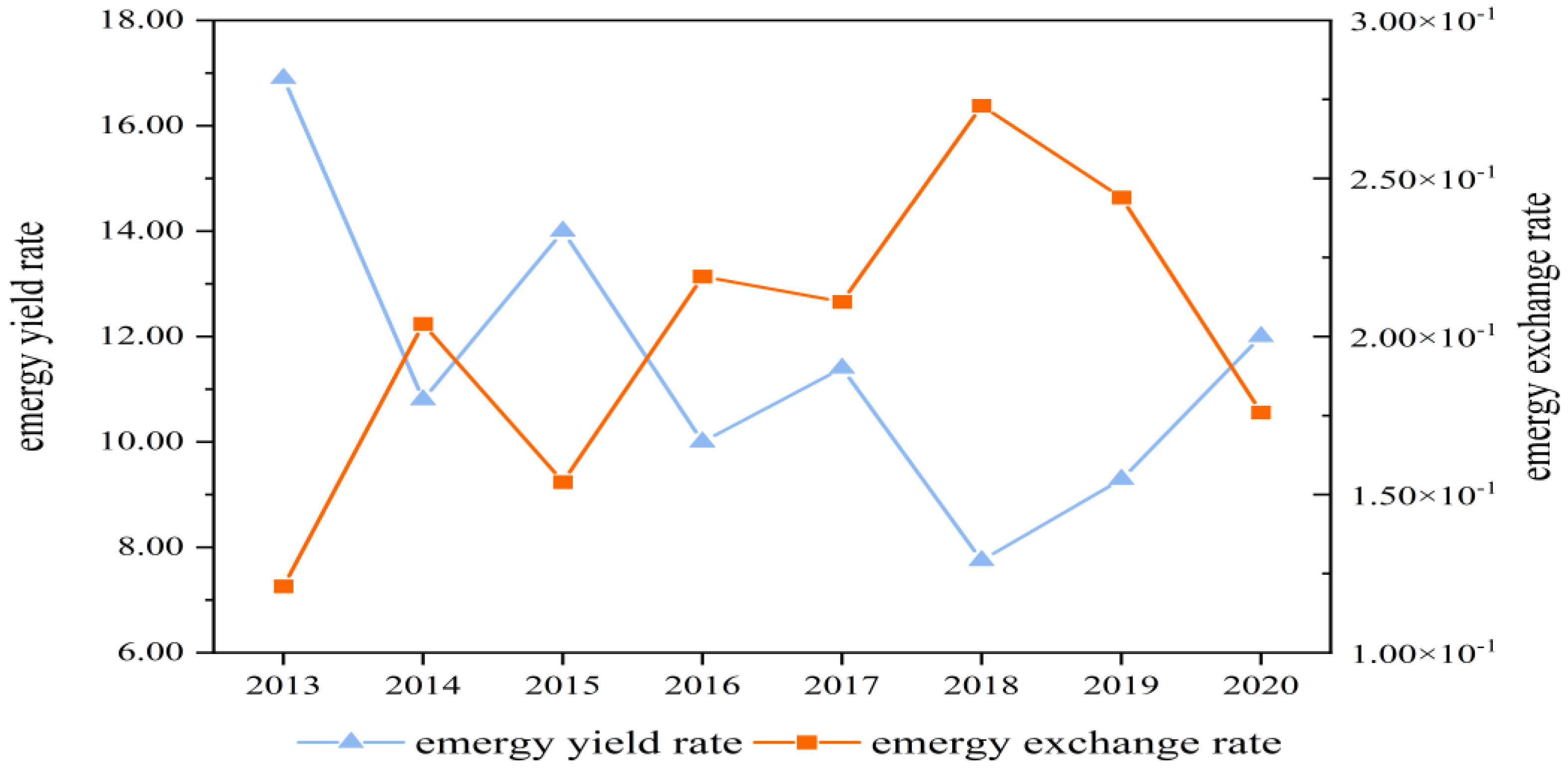
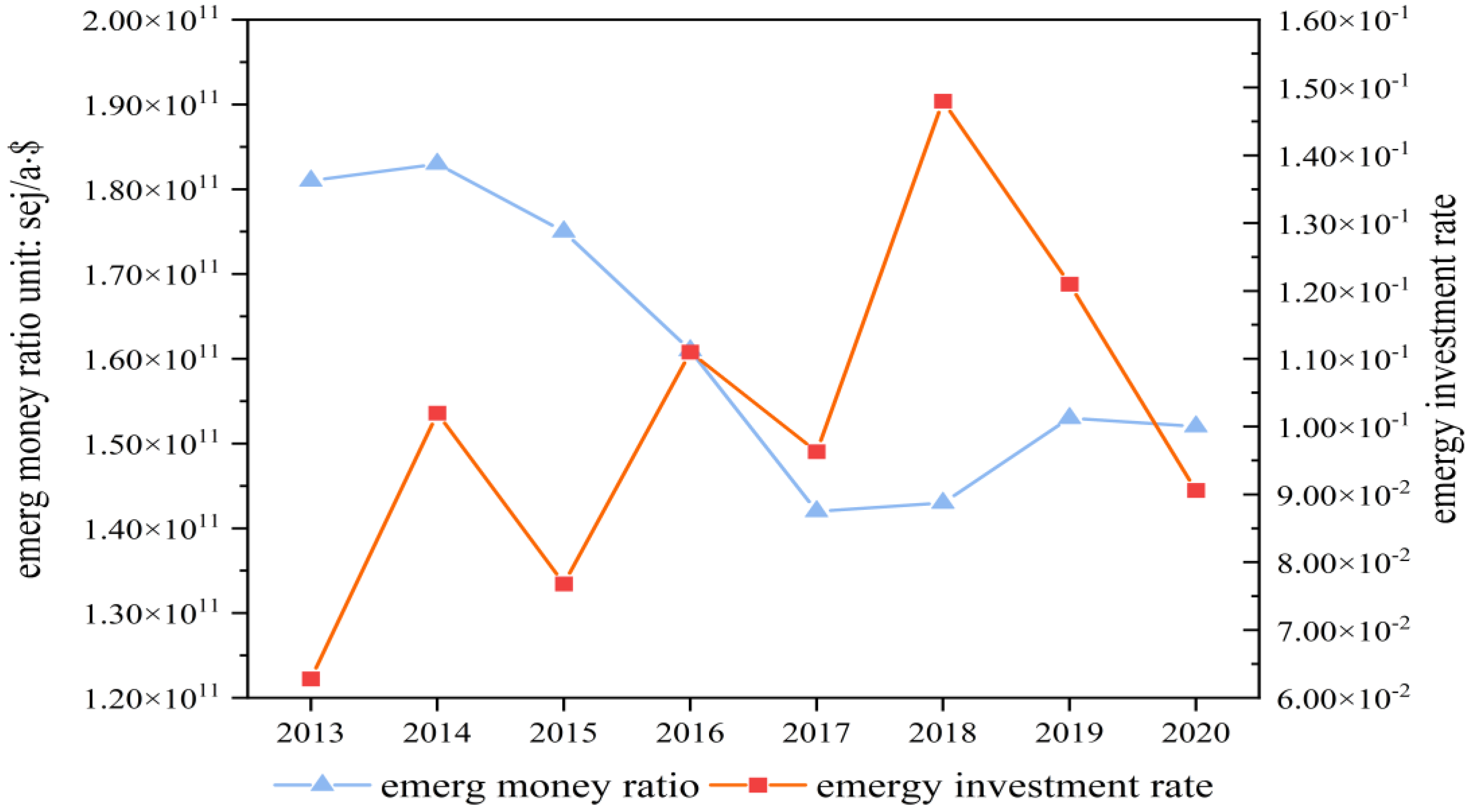
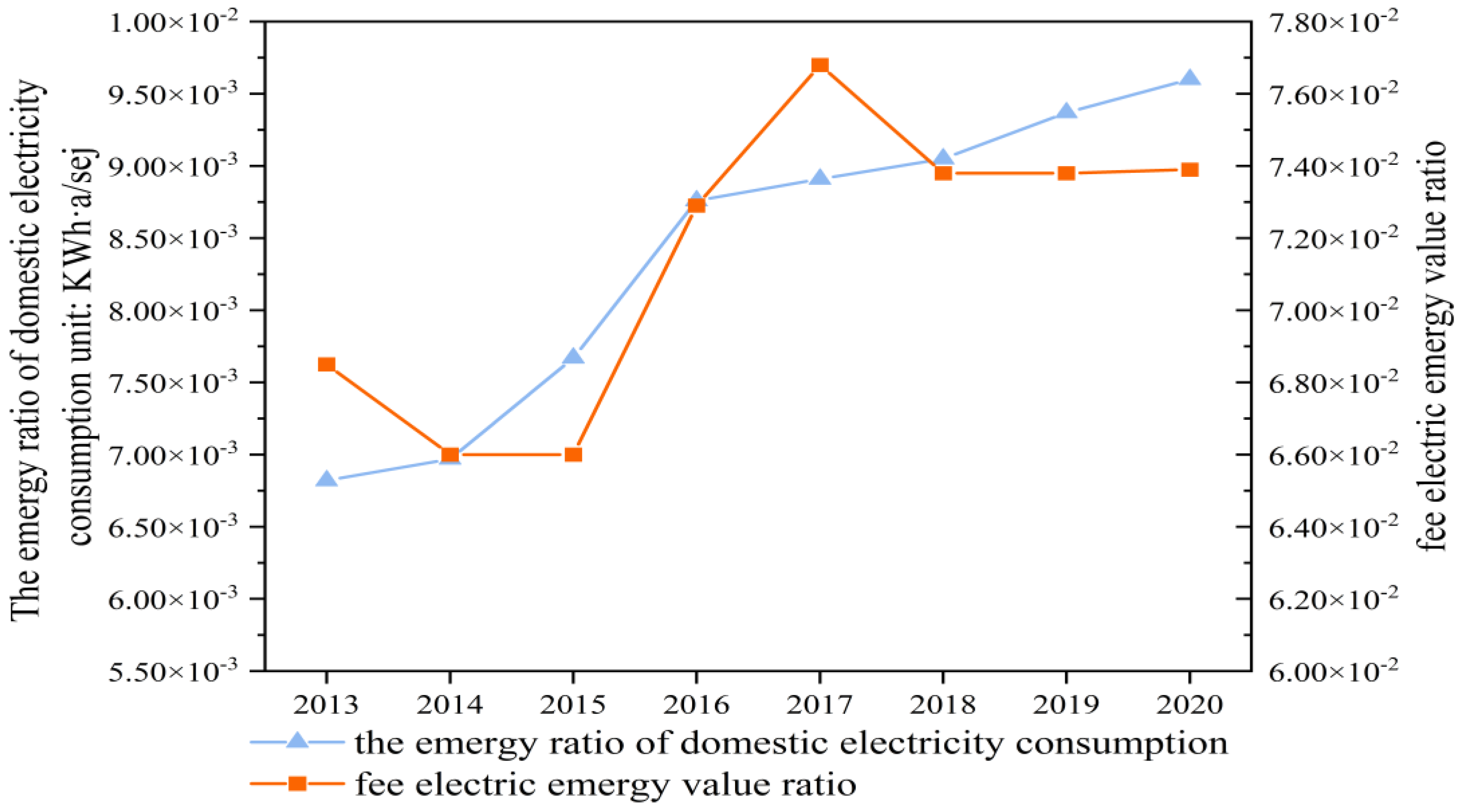
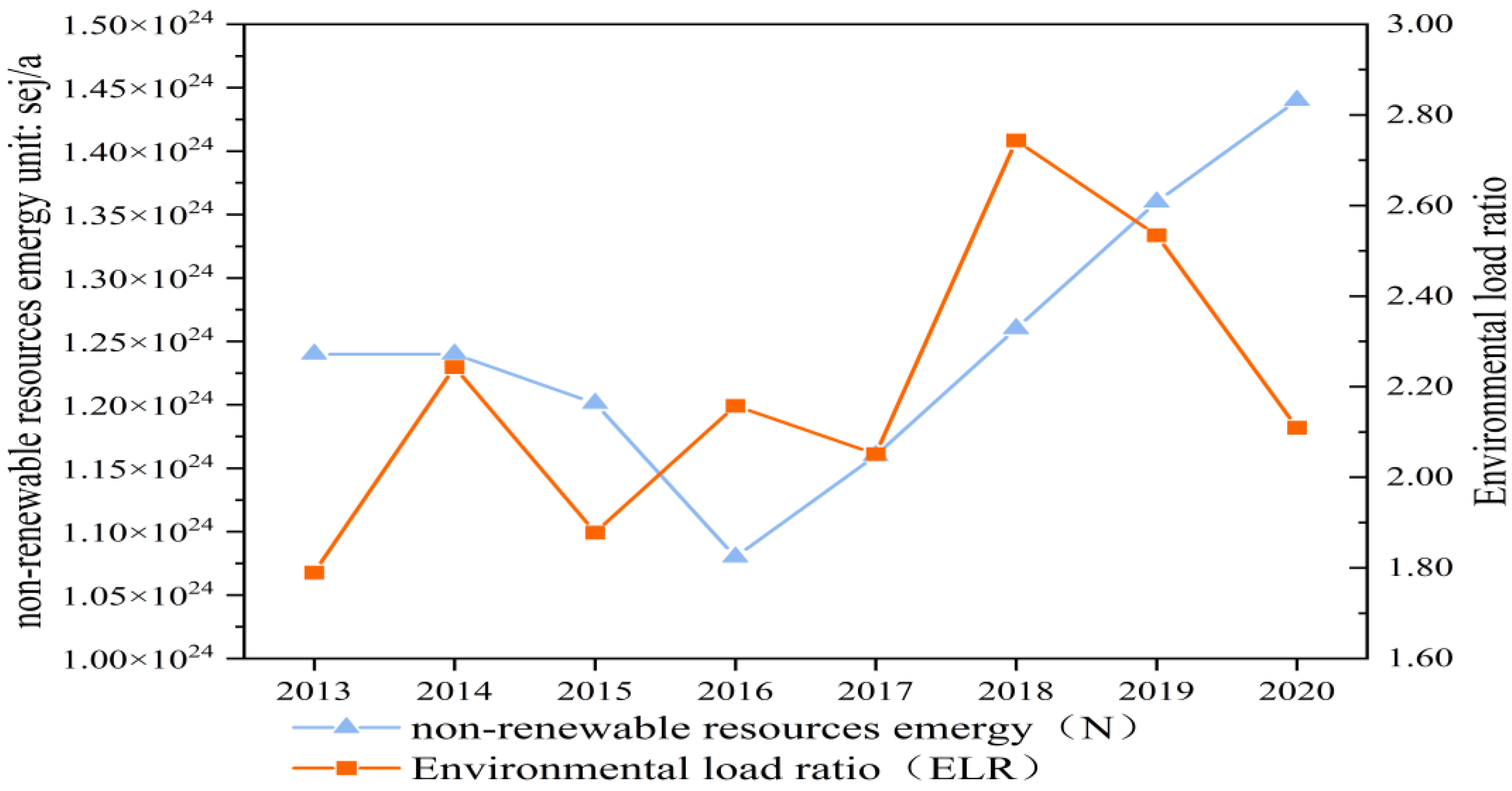
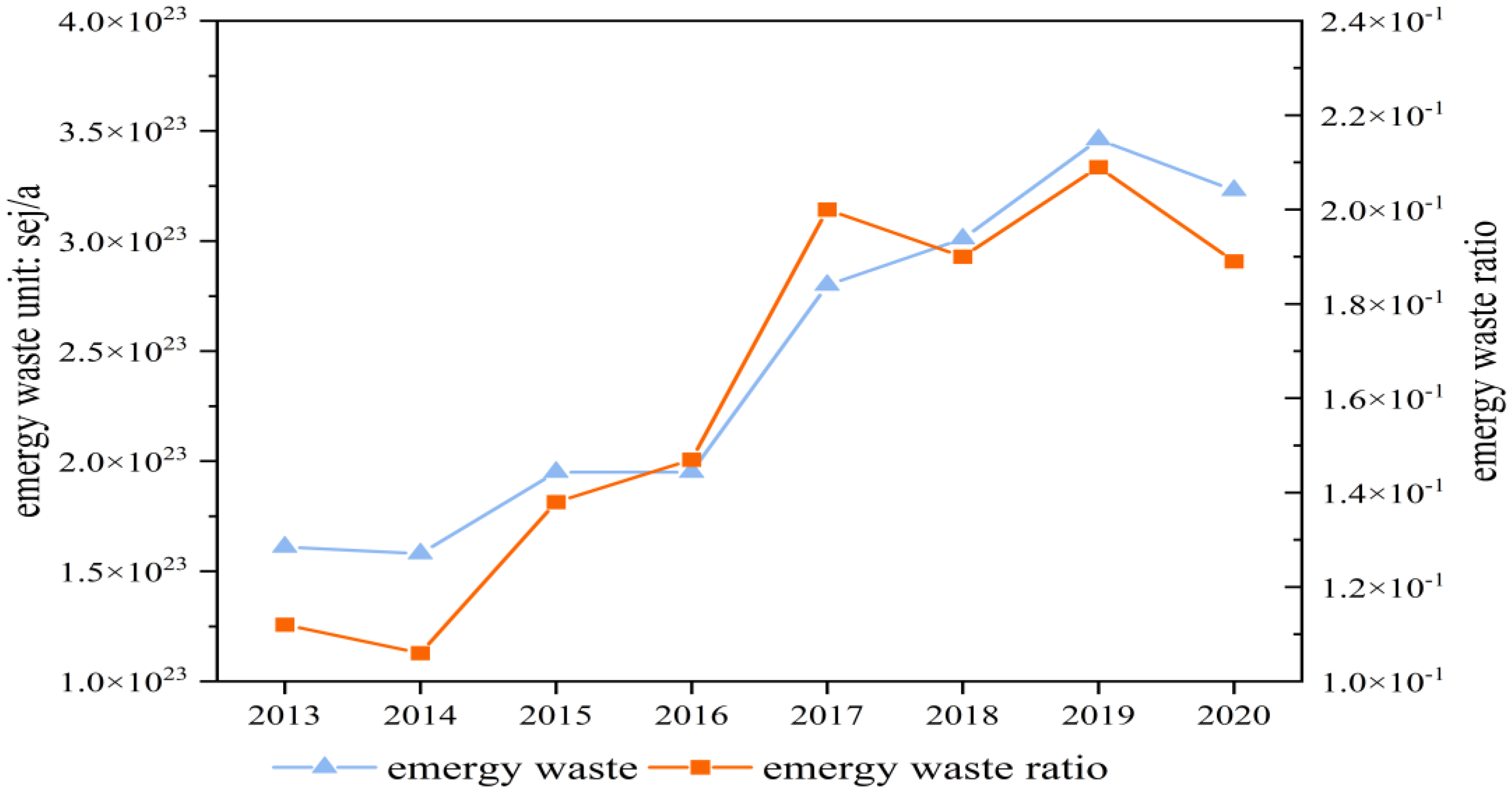
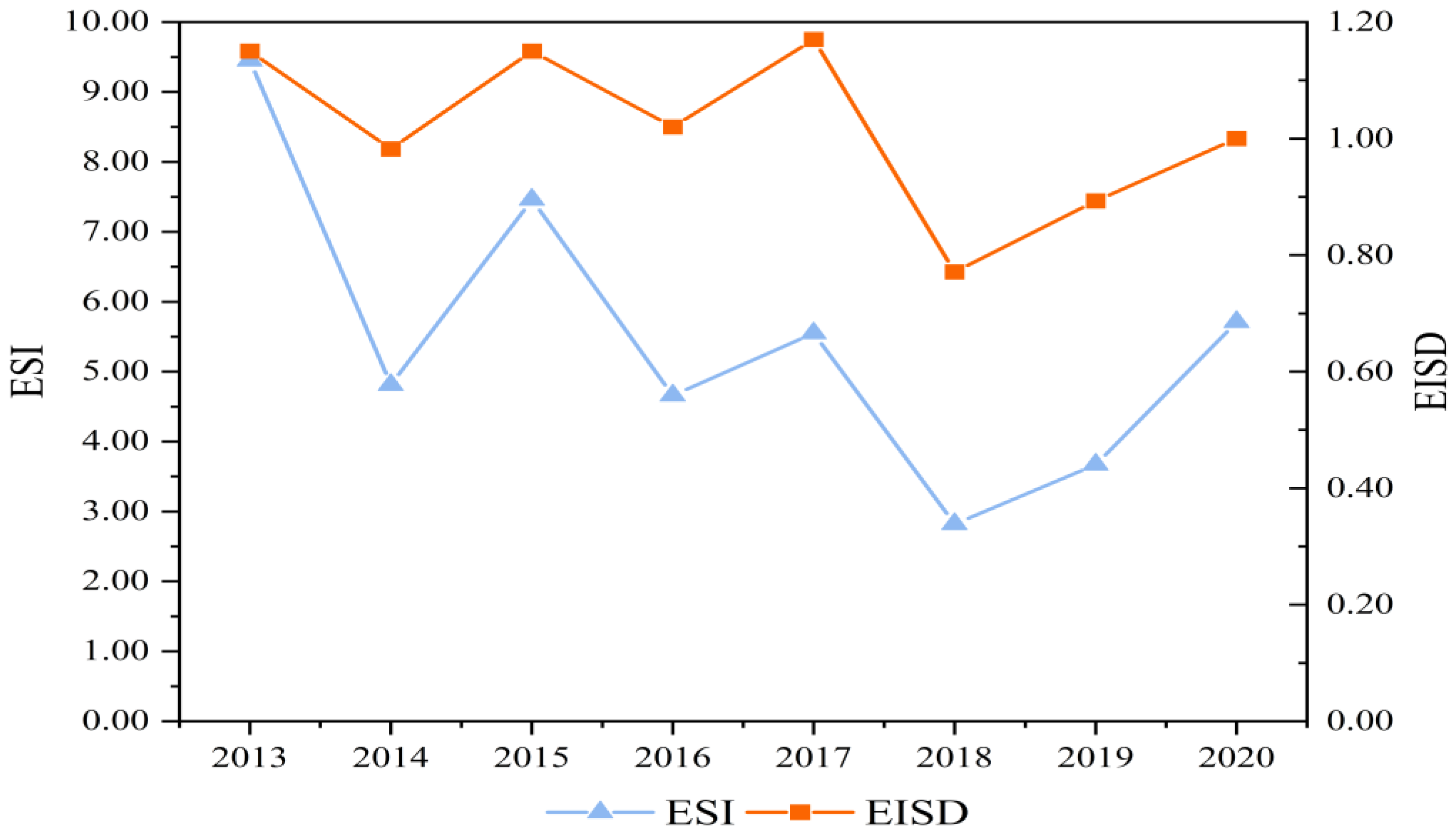
| Emergy Index | Formula | Explanation |
|---|---|---|
| Basic emergy quantity | ||
| 1. Renewable resource emergy (R) | R = R1 + R2 + S | Foundation of wealth of the system |
| 2. Nonrenewable resource emergy (N) | N = N1 + N2 | |
| 3. Input emergy (I) | I | Input resources, commodity wealth |
| 4. Output emergy (O) | O | Export resources, commodity wealth |
| 5. Total emergy (U) | U = R + N + I | Total wealth of the system |
| Social subsystem evaluation index | ||
| 6. Actual population (P) | P | Current local population |
| 7. Population carrying capacity (PCC) | PCC = 8 × (R/U) × P | The number of people that can be supported by renewable resources and input resources under current living standards |
| 8. Energy density (ED) | Ed = U/area | Emergy intensity |
| 9. Emergy per person (EPP) | EPP = U/P | A sign of regional living standards and quality |
| Economic subsystem evaluation index | ||
| 10. GDP | ||
| 11. Emergy self-sufficiency ratio (ESR) | ESR = (R + N)/U | Degree of external communication and economic self-sufficiency of a region |
| 12. Emergy yield rate (EYR) | EYR = (U/I) | Quality of industrial benefits |
| 13. Emergy exchange rate (EER) | EER = I/O | Gains and losses of external exchanges |
| 14. Emergy investment rate (EIR) | EIR = I/(R + N) | Degree of economic development and environmental load |
| 15. Emergy monetary ratio (EMR) | EMR = U/GDP | Development degree of the regional economy |
| 16. Social energy value of electricity (SEE) | SEE = SE/U | Modern level of residents’ life |
| 17. Energy-to-use ratio of electricity (FEE) | FEE = E/U | Level of industrialization |
| Environmental subsystem evaluation index | ||
| 18. Environmental load ratio (ELR) | ELR = (N+I)/R | Environmental carrying capacity of the system |
| 19. Emergy of waste (W) | W | Amount of waste |
| 20. Emergy waste ratio (EWR) | EWR = W/U | Waste pressure on the natural environment |
| Sustainable development evaluation index | ||
| 21. Sustainable development index (ESI) | ESI = EYR/ELR | Sustainable development evaluation based on emergy |
| 22. Evaluation system sustainable development indicators (EISD) | ESID = EYR × EER/ELR | Sustainability and natural environmental pressure as a function of economic benefits and environmental pressure |
| Emergy Index | 2013 | 2014 | 2015 | 2016 | 2017 | 2018 | 2019 | 2020 |
|---|---|---|---|---|---|---|---|---|
| Basic emergy quantity | ||||||||
| 1. Renewable resource emergy (R) (sej/a) | 1.08 × 1023 | 1.11 × 1023 | 1.15 × 1023 | 1.14 × 1023 | 1.17 × 1023 | 1.17 × 1023 | 1.16 × 1023 | 1.28 × 1023 |
| 2. Nonrenewable resource emergy (N) (sej/a) | 1.25 × 1024 | 1.24 × 1024 | 1.20 × 1024 | 1.08 × 1024 | 1.16 × 1024 | 1.26 × 1024 | 1.36 × 1024 | 1.44 × 1024 |
| 3. Input emergy (I) (sej/a) | 8.53 × 1022 | 1.38 × 1023 | 1.01 × 1023 | 1.32 × 1023 | 1.23 × 1023 | 2.04 × 1023 | 1.78 × 1023 | 1.42 × 1023 |
| 4. Output emergy (O) (sej/a) | 7.03 × 1023 | 6.76 × 1023 | 6.57 × 1023 | 6.03 × 1023 | 5.82 × 1023 | 7.47 × 1023 | 7.31 × 1023 | 8.09 × 1023 |
| 5. Total emergy (U) (sej/a) | 1.44 × 1024 | 1.49 × 1024 | 1.42 × 1024 | 1.33 × 1024 | 1.40 × 1024 | 1.58 × 1024 | 1.65 × 1024 | 1.71 × 1024 |
| Social subsystem evaluation index | ||||||||
| 6. Actual population (P) (persons) | 3.53 × 107 | 3.53 × 107 | 3.52 × 107 | 3.51 × 107 | 3.51 × 107 | 3.50 × 107 | 3.50 × 107 | 3.49 × 107 |
| 7. Population carrying capacity (PCC) (persons) | 2.11 × 107 | 2.11 × 107 | 2.29 × 107 | 2.41 × 107 | 2.35 × 107 | 2.07 × 107 | 1.96 × 107 | 2.09 × 107 |
| 8. Energy density (ED) (sej/a∙m2) | 9.24 × 1012 | 9.53 × 1012 | 9.07 × 1012 | 8.49 × 1012 | 8.96 × 1012 | 1.01 × 1013 | 1.06 × 1013 | 1.09 × 1013 |
| 9.Emergy per person (EPP) (sej/a·person) | 4.09 × 1016 | 4.22 × 1016 | 4.02 × 1016 | 3.78 × 1016 | 3.99 × 1016 | 4.52 × 1016 | 4.73 × 1016 | 4.90 × 1016 |
| Economic subsystem evaluation index | ||||||||
| 10. GDP (USD) | 1.99 × 1011 | 2.02 × 1011 | 2.03 × 1011 | 2.05 × 1011 | 2.44 × 1011 | 2.65 × 1011 | 2.68 × 1011 | 2.79 × 1011 |
| 11. Emergy self-sufficiency ratio (ESR) | 9.41 × 10−1 | 9.07 × 10−1 | 9.29 × 10−1 | 9.00 × 10−1 | 9.12 × 10−1 | 8.71 × 10−1 | 8.92 × 10−1 | 9.17 × 10−1 |
| 12. Emergy yield rate (EYR) | 1.69 × 101 | 1.08 × 101 | 1.40 × 101 | 1.00 × 101 | 1.14 × 101 | 7.75 | 9.29 | 1.20 × 101 |
| 13. Emergy exchange rate (EER) | 1.21 × 10−1 | 2.04 × 10−1 | 1.54 × 10−1 | 2.19 × 10−1 | 2.11 × 10−1 | 2.73 × 10−1 | 2.44 × 10−1 | 1.76 × 10−1 |
| 14. Emergy investment rate (EIR) | 6.28 × 10−2 | 1.02 × 10−1 | 7.68 × 10−2 | 1.11 × 10−1 | 9.63 × 10−2 | 1.48 × 10−1 | 1.21 × 10−1 | 9.06 × 10−2 |
| 15. Emergy monetary ratio (EMR) (sej/a·USD) | 1.81 × 1011 | 1.83 × 1011 | 1.75 × 1011 | 1.61 × 1011 | 1.42 × 1011 | 1.43 × 1011 | 1.53 × 1011 | 1.52 × 1011 |
| 16. Social emergy value of electricity (sej/a) | 9.88 × 1022 | 9.83 × 1022 | 9.34 × 1022 | 9.67 × 1022 | 1.07 × 1023 | 1.17 × 1023 | 1.22 × 1023 | 1.26 × 1023 |
| 17. Emergy-to-use ratio of electricity (FEE) | 6.85 × 10−2 | 6.60 × 10−2 | 6.60 × 10−2 | 7.29 × 10−2 | 7.68 × 10−2 | 7.38 × 10−2 | 7.38 × 10−2 | 7.39 × 10−2 |
| Environmental subsystem evaluation index | ||||||||
| 18. Environmental load ratio (ELR) | 1.79 | 2.24 | 1.88 | 2.16 | 2.05 | 2.74 | 2.53 | 2.11 |
| 19. Emergy of waste (W) (sej/a) | 1.61 × 1023 | 1.58 × 1023 | 1.95 × 1023 | 1.95 × 1023 | 2.80 × 1023 | 3.01 × 1023 | 3.46 × 1023 | 3.23 × 1023 |
| 20. Emergy waste ratio (EWR) | 1.12 × 10−1 | 1.06 × 10−1 | 1.38 × 10−1 | 1.47 × 10−1 | 2.00 × 10−1 | 1.90 × 10−1 | 2.09 × 10−1 | 1.89 × 10−1 |
| Sustainable development evaluation index | ||||||||
| 21. Sustainable development index (ESI) | 9.45 | 4.81 | 7.46 | 4.66 | 5.55 | 2.82 | 3.67 | 5.71 |
| 22. Evaluation system sustainable development indicators (EISD) | 1.15 | 9.82 × 10−1 | 1.15 | 1.02 | 1.17 | 7.71 × 10−1 | 8.93 × 10−1 | 1.00 |
Publisher’s Note: MDPI stays neutral with regard to jurisdictional claims in published maps and institutional affiliations. |
© 2022 by the authors. Licensee MDPI, Basel, Switzerland. This article is an open access article distributed under the terms and conditions of the Creative Commons Attribution (CC BY) license (https://creativecommons.org/licenses/by/4.0/).
Share and Cite
Hou, F.; Chang, D.; Wang, Q. Assessment of the Sustainability of the Resource-Based Province Shanxi, China Using Emergy Analysis. Sustainability 2022, 14, 15706. https://doi.org/10.3390/su142315706
Hou F, Chang D, Wang Q. Assessment of the Sustainability of the Resource-Based Province Shanxi, China Using Emergy Analysis. Sustainability. 2022; 14(23):15706. https://doi.org/10.3390/su142315706
Chicago/Turabian StyleHou, Feiyu, Dunhu Chang, and Qinxia Wang. 2022. "Assessment of the Sustainability of the Resource-Based Province Shanxi, China Using Emergy Analysis" Sustainability 14, no. 23: 15706. https://doi.org/10.3390/su142315706
APA StyleHou, F., Chang, D., & Wang, Q. (2022). Assessment of the Sustainability of the Resource-Based Province Shanxi, China Using Emergy Analysis. Sustainability, 14(23), 15706. https://doi.org/10.3390/su142315706






